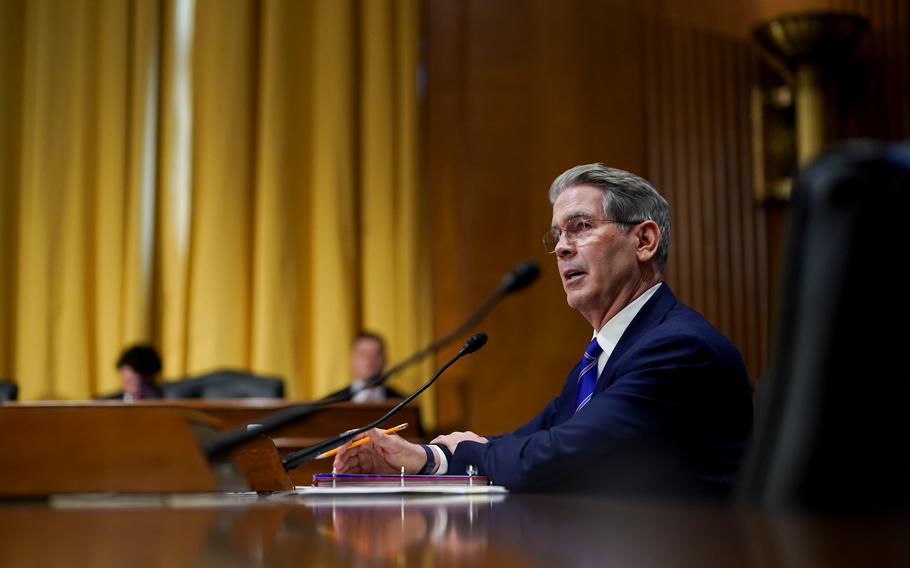
Bessent Sticks with Yellen-Era choices. (Al Drago/Bloomberg)
The U.S. Treasury on Wednesday maintained its guidance on keeping sales of longer-term debt unchanged well into 2025, despite newly installed Secretary Scott Bessent having criticized the issuance strategy of his predecessor before he was picked for the job.
At the helm of U.S. debt management policy for the first time, Bessent left broadly intact former Secretary Janet Yellen’s agenda.
The Treasury will next week sell $125 billion of debt in its so-called quarterly refunding auctions, which span 3-, 10- and 30-year maturities, the same amount as in the past several quarters.
“Based on current projected borrowing needs, Treasury anticipates maintaining nominal coupon and FRN auction sizes for at least the next several quarters,” the department said in its statement on issuance plans. Coupons refer to interest-bearing securities and FRN stands for floating-rate notes.
Similar language has been in place since the last bump up in auction sizes at the start of last year. Bessent, a former hedge fund manager, along with a number of Republicans had charged Yellen with having held down longer-dated debt sales in order to depress long-term borrowing costs and aid the economy before the election.
The forward guidance was maintained even as the Treasury Borrowing Advisory Committee — a panel of outside advisers composed of dealers, fund managers and other market participants — “uniformly encouraged Treasury to consider removing or modifying” it, a separate statement showed Wednesday. “Some members preferred dropping the language altogether to reflect the uncertain outlook, though the majority preferred moderating the language at this meeting.”
Treasury decides
The gap of long-term yields above rates on Treasuries with shorter maturities narrowed after the refunding announcement. Ten-year yields were down about nine basis points to 4.42%, while rates on two-year notes were lower by almost five basis points.
A senior Treasury official told reporters, when asked about that guidance, that TBAC offers recommendations, but they are just that, and it’s the department that decides.
Dealers had widely predicted auction sizes would remain stable next week, but given projections for continued outsize U.S. fiscal deficits, they have viewed increased sales of longer maturities as inevitable at some point. Before Wednesday’s announcement, many said the bump would come in November, while some saw it happening as early as August. Strategists at Morgan Stanley, by contrast, didn’t expect a change until next year.
And while a number of dealers expected unchanged language, it was viewed as a close call. Jefferies said after the release that it came as a surprise.
“We expected Treasury to edit this guidance on near-term coupon issuance to reflect the passage of time, if nothing else,” Thomas Simons, a senior economist at Jefferies wrote in a note. “Bessent has been critical of his predecessor’s reliance on short-term bill issuance, implying an intention to increase issuance in longer maturities. Today’s announcement suggests that this term-out is going to take a long time to execute.”
As for next week’s auctions, the $125 billion will be made up of the following:
$58 billion of 3-year notes on Feb. 11. $42 billion of 10-year notes on Feb. 12.
$25 billion of 30-year bonds on Feb. 13. The refunding will raise new cash of about $18.8 billion.
The Treasury on Wednesday also said it was keeping issuance of floating-rate debt unchanged, while continuing to nudge sales of some Treasury Inflation Protected Securities, or TIPS, higher.
Over the coming three months, the Treasury said it plans to use bills — which mature in up to a year — to address any seasonal or unexpected variations in borrowing needs.
Since the start of this year, the Treasury has been constrained by the federal debt limit, which kicked back in after being suspended in mid-2023. The department has begun to use extraordinary measures to keep from a debt-ceiling breach.
Debt limit
“Until the debt limit is suspended or increased, debt limit-related constraints will lead to greater-than-normal variability in benchmark bill issuance and significant usage” of cash management bills, the department said. With regard to TIPS, the Treasury detailed the following adjustments for the February-to-April period: To increase the April 5-year TIPS new issue to $25 billion
Boost the March 10-year TIPS reopening by $1 billion, to $18 billion To maintain the size of the February 30-year TIPS new issue auction size at $9 billion Another complication for the Treasury’s debt sales in coming months and quarters is uncertainty when the Federal Reserve will halt, or slow further, its steady reduction in holdings of Treasuries — currently running at up to $25 billion a month. When the Fed does fully phase out its so-called quantitative tightening, it will reduce the amounts the Treasury needs to borrow from the public.
Dealers now see QT as ending in the summer, rather than spring, “slightly increasing the expected need for borrowing from the private sector in 2025,” TBAC reported to the Treasury. “Market participants viewed risks as skewed towards a later finish,” although factors including debt-limit dynamics may complicate the Fed’s assessment of whether there’s an “ample” magnitude of reserves in the system, TBAC said.
Wednesday’s statement also detailed a new schedule of buybacks for the early February through May.